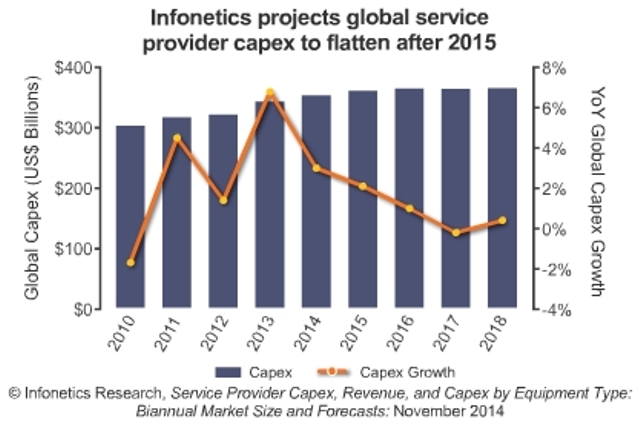Global telecom Capex (capital spending) will decrease from 2015, said Infonetics Research, a IHS company.
2013 was the year when telecom operators’ Capex touched the peak. Last year (2014), telecom Capex dipped. From 2015 onwards, telecom Capex will decline further. The below shown chart indicates a slight recovery in Capex in 2018.
You can watch and subscribe: Latest videos on telecoms
Ovum predicts flat growth in Capex
Ovum, a research agency last month said that growth in Capex by telecom service providers will be flat to $346 billion in 2015.
Infonetics Research predicts a decline in Capex in 2015 over 2014.
In 2014, Ovum said, Capex in fixed line telecom operations was 41 percent of $346 billion, while 59 percent was in wireless business of operators.
In 2015, Ovum forecasts that Capex of mobile operators will grow as compared with 2014, while fixed line telecoms’ Capex will decline. Ovum did not share specific break-up between wireless and wireline Capex for 2015.
Last month, telecom industry body GSMA said telecom operators will invest $1.7 trillion on Capex during 2014-2020.
ALSO READ: Telecoms to invest $1.7 trillion as Capex in networks during 2014-2020
Ovum says Capex of telecom operators are forecast to total more than $2 trillion between 2014 and 2019. Capex will be weak for both the fixed and mobile segments in 2016 and 2017.
Infonetics Research said global mobile service revenue rose 0.5 percent in the first half of 2014, badly dragged by Europe again.
The anticipated decline in Capex by Infonetics Research is a not a good news for telecom network vendors such as Alcatel-Lucent, Cisco, Ericsson, Huawei, Nokia Networks, ZTE, etc.
Telecom revenue trends
The telecom analysis firm said growth in telecom revenue continues to slow in every geographic region. Europe’s 5 top telecom service providers — Deutsche Telekom, Orange, Telecom Italia, Telefonica and Vodafone — continue to experience declining revenue.
In North America, AT&T and Verizon have signaled that the mobile services price war started by T-Mobile US is taking a bite, said Stephane Teral, principal analyst for mobile infrastructure and carrier economics at Infonetics Research.
Mobile data services — text messaging and mobile broadband — rose again in every region in H1 2014, driven by the increasing usage of smartphones.
Mobile broadband services grew 26 percent, enough to offset the decline of SMS revenue.
Key trends affecting the enterprise networking and communication markets include the adoption of cloud services, the use of cloud architectures in enterprise data centers, and security becoming a part of every IT decision.
“After a weak 2013, enterprise networking and communication revenue growth accelerated in 2014 thanks to a resurging North American market and stepped-up investments in security infrastructure. We expect similar results in 2015, when strong end-user demand in North America and Asia Pac is likely to be offset by a slowdown in Europe,” said Matthias Machowinski, Infonetics’ directing analyst for enterprise networks.
Baburajan K
[email protected]






